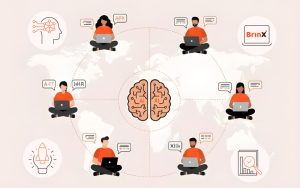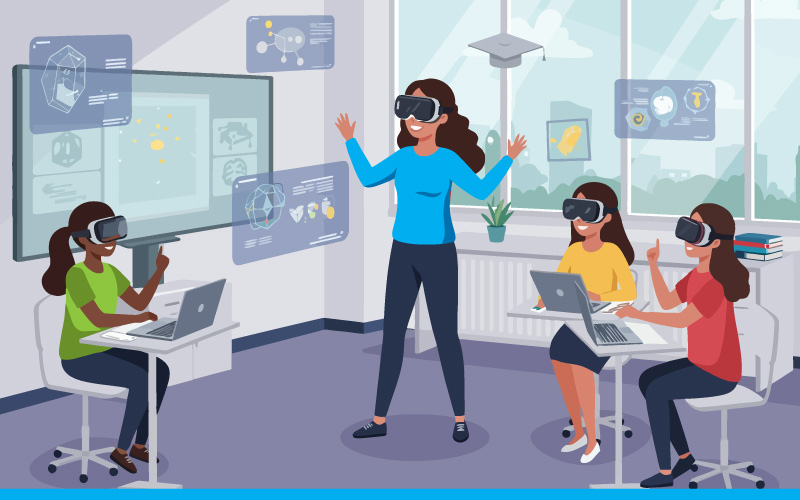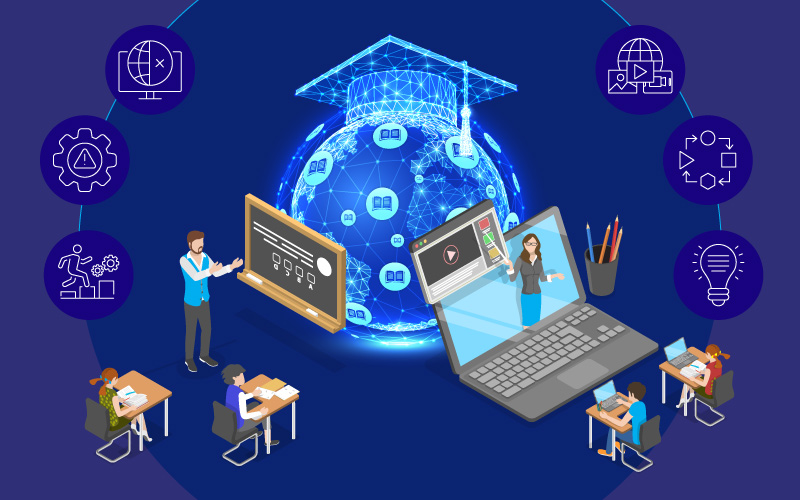Over the last decade, corporate training has steadily compressed. Course runtimes dropped from hours to minutes, learning objects from modules to clips, and assessments from tests to micro-checks. Nothing about this is accidental. It mirrors how attention and upskilling now operate inside modern enterprises.
Learning has moved closer to work. Employees search, apply, and move on. L&D teams track this; but rarely own it. Microlearning emerged to formalize what was already happening- knowledge consumed in fragments.
Yet, organizations discovered fragments alone were not enough. Completion rates improved, but recognition and proof of learning stayed weak. That gap led to the parallel rise of microcredentials. Small, verifiable proofs attached to skills or performance outcomes. Stackable. Portable.
The intersection of these two- microlearning and microcredentials– now forms a compact architecture for learning agility. One supplies the “how.” The other records the “what.”

Understanding Behavioral Alignment
Most adult learning theories underestimate one variable: digital fatigue. Learners do not just prefer shorter content because it is convenient. They prefer it because long content now competes with fragmented attention structures- notifications, workflow toggling, cognitive switching.
Microlearning fits this behavior. Not because it is smaller, but because it respects interruption. It assumes discontinuity. That is its real alignment.
In internal rollouts across financial and manufacturing firms, engagement spikes occurred only when microlearning was embedded between operational systems. When placed outside- separate platforms or optional links- retention fell below 40%. Integration, not duration, drove adoption.
So, the behavior match is clear. Learners multitask. Systems respond. L&D adapts. The question that follows: how does one make such learning measurable or credible enough to matter in talent decisions?
That is where the credentials enter the picture.

The Rise of the Credential Layer
Microcredentials convert transient learning moments into identifiable data. They do three things:
-
Define a skill or competency at a granular level
-
Link that definition to performance or verified completion
-
Allow stacking- one badge becomes part of a larger capability set
In higher education, digital badges began as recognition tools. In enterprises, they evolved into proof mechanisms. When tracked through Learning Record Stores or linked APIs, they create audit trails for capability development.
Some systems now align microcredentials directly to role architectures. A technician completing six microlearning units on IoT maintenance can automatically receive an operational credential recognized in the job framework. That credential then feeds into performance reviews or internal mobility data.
In short, the microcredential transforms learning fragments into organizational signals. Without it, microlearning remains anecdotal.

Why Stackability Redefines Learning Continuity
Most learning interventions fail because they reset too often. Each new initiative ignores prior data. Stackability changes that logic.
When microcredentials are designed to build on each other, they create a horizontal pathway through skill clusters. Instead of re-training similar content annually, employees accumulate verifiable proof that expands across functions.
For instance:
-
Safety microlearning (Level 1)- Operational Safety Credential
-
Equipment maintenance module (Level 2)- Technical Maintenance Credential
-
Both combined- Plant Operations Certificate
This architecture does not require new content. It requires relational mapping. Each small learning unit becomes a node in a skill graph. The value lies in continuity, not novelty.
Organizations with stackable systems report lower retraining costs and faster role mobility. That correlation is not causal, but consistent enough to note.

Uneven Implementation Across Enterprises
Adoption patterns vary. Large enterprises experiment widely; mid-sized firms hesitate due to infrastructure costs. Systems integration remains the barrier.
Some platforms can issue credentials but cannot verify them externally. Others support microlearning delivery but not progress tracking across modules. The result: islands of achievement.
Several L&D teams build workaround models using xAPI or HRIS integrations, mapping learning data into performance dashboards. The more mature implementations treat microcredentials as data objects, not as marketing tokens. That distinction matters.
Evidence from internal audits shows a repeated issue- credential inflation. Too many badges with unclear value reduce credibility. Microcredentials only function if scarcity and specificity are maintained.

Where Microlearning Shows Measurable Impact
Engagement data can be misleading. A true act appears when microlearning helps employees make faster, more accurate decisions in the flow of work.
Example cases:
-
A logistics firm reduced onboarding time by 25% after shifting compliance content into micro modules embedded within shift apps.
-
A retail chain used five-minute reinforcement units for POS updates. Error rates dropped despite the turnover.
-
A healthcare network linked micro-assessments to digital credentials; audit readiness improved without adding training hours.
The pattern across sectors is consistent- microlearning functions best as workflow augmentation, not as a replacement for structured learning. It extends the shelf life of knowledge.
Microcredentials then document that extension. Together, they close the loop between consumption and recognition.

The Economics of Microlearning Adoption
On an enterprise scale, business logic matters more than pedagogy. Microlearning reduces downtime. Microcredentials reduce verification costs.
Consider compliance cycles. Traditional audits rely on the completion of certificates, often disconnected from real performance. Credentialed microlearning enables traceability- each completion links to a defined skill outcome, time-stamped, and stored. Audit time shortens. Data confidence rises.
From a cost perspective:
-
Production cost per minute of learning drops when modular content is reused.
-
Maintenance cost decreases when updates target only change fragments.
-
ROI increases when learning hours correlate with operational metrics instead of course completions.
This alignment is not automatic. It requires L&D to collaborate with IT and analytics teams. The advantage is cumulative. Over time, microlearning becomes infrastructure, not intervention.

Structural Limits and Governance Gaps
No model scales cleanly. Three persistent challenges remain:
-
Fragmentation of Data- multiple systems, inconsistent tagging, weak interoperability.
-
Verification Standards- credential frameworks differ across vendors; portability suffers.
-
Cultural Resistance- some managers still equate long training hours with rigor.
These are not technical flaws. There are governance gaps. The technology stack for microlearning and microcredentials already exists. What lags is institutional clarity- who defines value, who validates performance, who retires outdated credentials.
Enterprises resolving these governance issues often shift from learning management to learning intelligence. The goal is not delivery, but discernment- knowing what learning actually affects work output.

The Road Ahead
Microlearning and microcredentials are not trends; they are compression tools. They compress time, attention, and validation cycles. What used to take months- course creation, rollout, certification- now occurs in parallel with work itself.
The structure of learning is changing from programmatic to atomic. Each unit- whether video, simulation, or quiz- carries measurable weight. Credentials attach to those units, forming a traceable lattice of capability.
There is no clear endpoint. Adoption will not stabilize; it will normalize. As workforce systems mature, microlearning becomes the default delivery mode and microcredentials the default proof mechanism. The enterprise learning stack shifts from curriculum to continuum.
That may be the real impact- not how small the content is, but how precisely it fits into the ongoing architecture of work.
FAQ's
Why is accessibility essential to STEM education for students with special needs?
Accessibility to STEM eLearning means that all students (of both genders and with special needs) get to be partakers of learning programs. It's a step towards eliminating educational inequalities and fostering multiverse innovation.
In STEM education, what are some common problems encountered by students with special needs?
Some common issues are course format that is not complex, non-adapted labs and visuals, insufficient assistive technologies, and no customized learning resources. Besides this, systemic issues such as learning materials that are not inclusive, and teachers who are not trained.
How can accessibility be improved in STEM eLearning through Universal Design for Learning (UDL)?
Through flexible teaching and assessment methods, UDL improves accessibility in STEM content. Also, UDL allows learners to access and engage content in multiple ways and demonstrate understanding of content.
What are effective multisensory learning strategies for accessible STEM education?
Examples of multisensory learning strategies in accessible STEM include when students use graphs with alt-text, auditory descriptions of course materials, tactile models for visual learners through touch, captioned videos for auditory learners, and interactive simulations to allow boys and girls choice in how they have access to physical, visual, auditory, video and written content representation.
Identify the assistive technologies required for providing accessible STEM material?
In order to provide access to STEM material, technologies like screen readers, specially designed input app for mathematics, braille displays, accessible graphing calculators are required.
How can STEM educators approach designing assessments for students with special needs?
To create content for students with special needs, tactics such as creating adaptive learning pathways in more than one format, oral and project assessments and multiway feedback will prove to be beneficial.
What is the role of schools and policymakers in supporting accessible STEM education?
Educational institutions should focus on educating trainers and support staff, also they can invest in assistive technology, and work towards curricular policies.
Can you share examples of successful accessible STEM education initiatives?
Initiatives like PhET Interactive Simulations, Khan Academy accessible learning resources, Labster virtual laboratory simulations, and Girls Who Code’s outreach are examples of effective practice.
How can Mitr Media assist in creating accessible STEM educational content?
Mitr Media is focused on designing and building inclusive e-learning platforms and multimedia materials with accessibility standards in mind so that STEM material is usable by all learners at different levels of need.
What value does partner with Mitr Media bring to institutions aiming for inclusive STEM education?
Mitr Media has expertise in implementing assistive technology, enacting Universal Design for Learning, and providing ongoing support to transformation organizations, enabling their STEM curriculum into an accessible and interesting learning experience.
- Unnati Umarehttps://www.mitrmedia.com/resources/blogs/author/unnati_u/
- Unnati Umarehttps://www.mitrmedia.com/resources/blogs/author/unnati_u/
- Unnati Umarehttps://www.mitrmedia.com/resources/blogs/author/unnati_u/
- Unnati Umarehttps://www.mitrmedia.com/resources/blogs/author/unnati_u/









